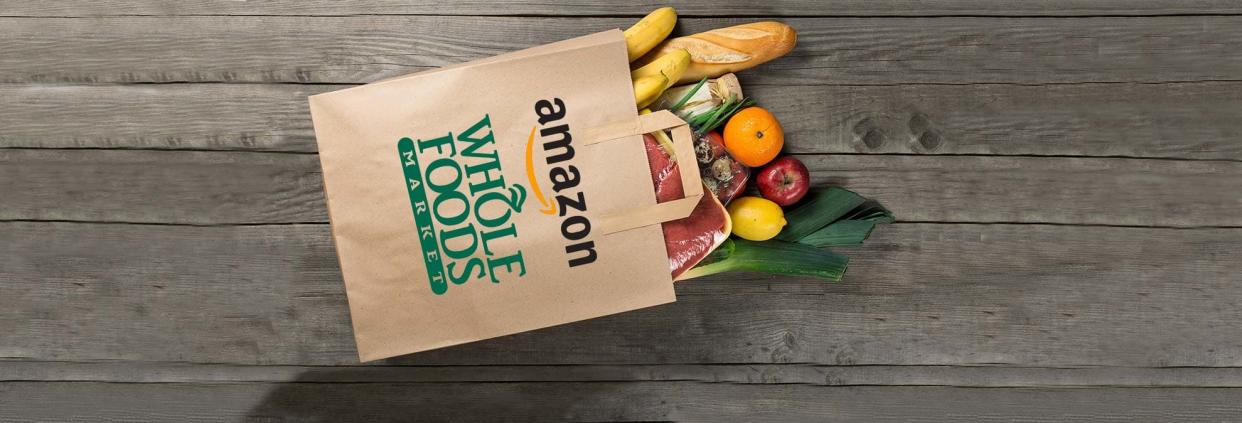Amazon Charts Future of Food Shopping With Whole Foods Deal

Consumer Reports has no relationship with any advertisers on this website.
Amazon's plan to acquire Whole Foods conjures new possibilities for how consumers buy food.
Think drone deliveries of organic fair-trade sugar when you’re already making cupcakes. Or your Amazon Echo smart speaker finding a recipe for lasagna and ordering the ingredients, while cranking out soothing tunes for you.
Retail analysts and others say these futuristic scenarios of convenience could grow from the powerhouse combination of Amazon and Whole Foods in a $13.7 billion deal announced Friday.
Amazon became the world’s biggest retailer by disrupting one business after another. With the Whole Foods deal, the giant online retailer seems poised and determined to alter the old-line grocery industry, as it pulls consumers further into its highly convenient and ever-growing ecosystem.
Ryan Brazelton, executive creative director for Interbrand, a global consultancy, says the acquisition will help Amazon move into more areas of a consumer's life. “The experience and reach within [traditional] retail is what Amazon didn't have before,” Brazelton says. “And now they can integrate their technology into retail.”
The Amazon eco-system already includes Prime membership with its two-day free shipping and video and music libraries, along with the Echo smart speaker, the newly re-released Dash Wand that scans products to order them again, and soon possibly the ability to pick up groceries at a physical store. And of course Amazon is experimenting with deliveries by drone.
What Amazon Might Do First
Amazon already has made inroads into the supermarket business with its AmazonFresh grocery delivery service and a prototype checkout-free Amazon Go brick-and-mortar store, so far only open to employees.
These early forays into groceries provide clues for what consumers could expect from a combined Amazon and Whole Foods, a deal expected to close later this year.
At first, consumers likely will see Whole Foods products in the AmazonFresh lineup, and just for Prime members. Amazon would be able to sell Whole Foods prepackaged meals, which make up about 20 percent of Whole Food’s sales now, Stone says.
“Amazon can now answer the question, What are we having for dinner,” he says.
Any number of Whole Foods locations — more than 460 in the U.S., Canada and Britain — could be used as jumping off points for wider delivery and pickup of groceries and prepared foods ordered online.
Inside the stores, Whole Foods customers could see big changes, including easier checkouts.
The Amazon Go pilot store allows customers to choose items and then pay the bill automatically by just walking out of the store, all without going to a cash register.
Amazon says in a statement that it has “no plans to use the technology developed for Amazon Go to automate the jobs of cashiers at Whole Foods.” It adds that it plans no job cuts as part of the deal. (Amazon declined to comment for this story beyond that statement.)
But Stone expects that Amazon might find a way to integrate some of the systems found at the GO store. The technology could free up employees to interact with customers about products, the same as in the company’s brick-and-mortar bookstores, he says.
“In this age of instant gratification, the idea of waiting in line feels a bit anachronistic,” Stone says. “People don’t have the patience for it.”
Whole Foods customers who are Amazon Prime members, meanwhile, could get discounts on certain products. “When you walk into an Amazon bookstore, it’s a temple to Prime,” Stone says.
Consumers could also see more Whole Foods stores thanks to Amazon’s financial might. Stone sees the possibility that Whole Foods CEO John Mackey could do what he’s wanted to do, expand the chain to about 1,000 stores from its current stable of more than 460.
And Amazon could turn to dealmaking again. “What we’ll be watching next is whether Amazon makes a second big bet in brick-and-mortar by buying another established player, one that sells clothing and other items for example,” says Bankrate’s Hamrick says. “It still has the option to stand up its own Amazon-branded stores from the ground up."
Bree Fowler contributed to this story.
More from Consumer Reports:
Top pick tires for 2016
Best used cars for $25,000 and less
7 best mattresses for couples
Copyright © 2006-2017 Consumer Reports, Inc.

